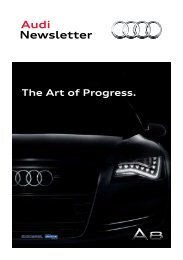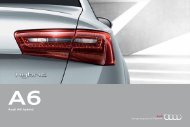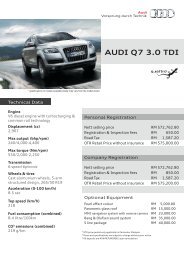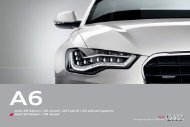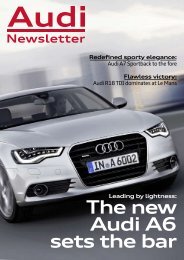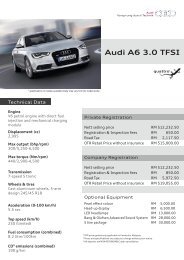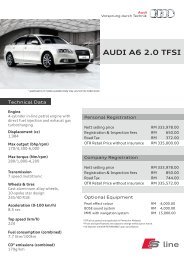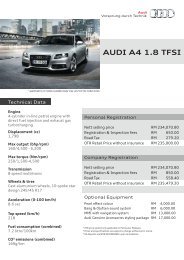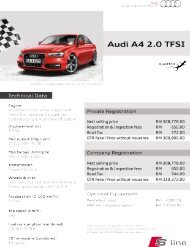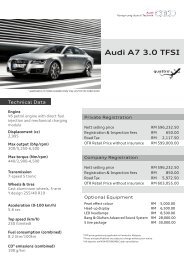drive - Audi
drive - Audi
drive - Audi
Create successful ePaper yourself
Turn your PDF publications into a flip-book with our unique Google optimized e-Paper software.
Cd of 0.30. This was a figure rival aerodynamics engineersmay have had to read twice before they believedit, as it was previously thought impossible for a mainstreamproduction car to achieve such a low number.“No one remembers who came in second,”Walter Hagen, the American golfer of the 1920s, fa-The critics were also impressed by the<strong>Audi</strong> 100, naming it 1983 European Car of the Year. AndThe <strong>Audi</strong> Wind Tunnel Centermously observed. Harsh words, but true all the same.However, the car you see here most definitely camefirst, albeit 30 years ago. And what catapulted this1982 <strong>Audi</strong> 100 so far beyond the competition was itsability to slip through the air quite unlike any previousmainstream production car.The creation of the car’s streamlined body shaperequired endless hours of painstaking, pioneeringwork—all carried out in strictest secrecy as the <strong>Audi</strong> engineersbroke new ground in the field of aerodynamics.even if customers did not fully understand what the Cdbadge signified, the advances the <strong>Audi</strong> 100 boastedin fuel efficiency and performance were easy to grasp.“The car’s four-cylinder, 75-horsepower engine may nothave been very powerful,” Mr. Zimmermann says, “butbecause the <strong>Audi</strong> 100 was able to move so smoothlythrough the air, it offered the performance of a muchlarger engine while delivering excellent fuel efficiency.”How does he rate the work of his predecessorstoday? “You can see that the overall shape of thealso receive ample praise from Mr. Zimmermann. “TheThe <strong>Audi</strong> Wind Tunnel Center is located in Ingolstadt on a10,000-square-meter site. There are three wind tunnels locatedhere: aeroacoustic, thermal and climatic. The facilityemploys 56 people and costs €100,000 a month to operate.The aeroacoustic wind tunnel tests how easily a car can slipthrough the air, and how quiet it is at speed. A 3.6-megawattrotor measuring five meters in diameter produces theairflow. Maximum wind speed is 300 kilometers per hour,although most aeroacoustic work is carried out at around140 kilometers per hour. With a noise level of just 6 dB (A),the four rings’ aeroacoustic facility is the quietest wind tunnelin the world.All the engineers from that time are now retired.But Klaus Zimmermann, who is today in charge ofthe ultra-modern <strong>Audi</strong> Wind Tunnel Center, remembers<strong>Audi</strong> 100 is aerodynamic,” he begins. “Other cars atthe time had much straighter shapes with very sharp,upright contours. This car’s lines are much smoother,wheel arch is the area that interrupts airflow the mostin a vehicle. Even today, this area remains a huge challenge,but we can see that back in 1982 the engineersThe thermal wind tunnel has a maximum airspeed of 275kilometers per hour but air temperature can be varied between+20°C and +55°C.exactly what a tremendous impact the <strong>Audi</strong> 100 madewhen it arrived. Back then, Mr. Zimmermann was workingas a junior aerodynamic engineer at a rival Germancar company.“When the <strong>Audi</strong> 100 came out, it was just sofar ahead of what everyone else was doing,” Mr. Zimmermannrecalls. “In a way, it was good for us workingwhich greatly assists airflow.”Along with the car’s overall form, there is noshortage of detail to illustrate just how innovative the<strong>Audi</strong> engineers were. For example, narrow tires helpedreduce drag, as did the window glass, which for the firsttime was fitted flush to the body.The wheel covers on the <strong>Audi</strong> 100 and thesmooth, flat panels surrounding the wheel archesunderstood the problem and took steps to deal with it.”And even the humble side mirrors tell a story.“Before, car mirrors tended to stick straight out andhad exposed brackets, unlike the smooth finish we seehere,” reveals Zimmermann. There is more to learn underthe hood, too. “A car’s cooling system creates a lotof drag, but this was the first time we saw ducting usedto guide the air through—again, it was very far aheadThe climatic tunnel is the newest, having opened in 2008. Ithas a maximum wind speed of 300 kilometers per hour andcan produce temperatures ranging from -25°C to +55°C.The <strong>Audi</strong> engineers can replicate desert-like sun with up to1,000 watts per square meter, or simulate a monsoon-likerainstorm by delivering up to 2,500 liters of water per hour.Staff must undergo special medical tests to ensure they arein good enough physical shape to work in such a variety ofconditions.at a rival company,” he adds with a smile, “because suddenlyeveryone took aerodynamics very seriously, andall at once our department was given a lot of money forof its time.”There is one area, though, that those engineersof three decades ago were not able to influ-It’s not just cars that are tested in the wind tunnel; the engineersat <strong>Audi</strong> have also helped skiers, cyclists, and evenswimmers raise their game.aerodynamic development. Even so, it still took five orsix years to catch up.”Suddenly, too, the importance of vehicle aero-ence: the flow of air underneath the car. “Today, ona modern <strong>Audi</strong>,” Zimmermann explains, “everythingapart from the exhaust is shielded, and this allowsFor further information go towww.audi.com.dynamics—a science previously only grasped by a hand-the air to flow much more smoothly under the body.ful of engineers—entered the public arena thanks to aThis is an area that has really advanced in the last 30successful <strong>Audi</strong> marketing campaign focusing on theyears. But, given the tools they had back then, the en-car’s drag coefficient, or Cd value. This figure revealsgineers who worked on this car did a remarkable job.”how easily a vehicle can slip through the air—the lowerthe number, the better. The 1982 <strong>Audi</strong> 100 recorded aAnd if those engineers were to visit the <strong>Audi</strong>Wind Tunnel Center now, what might they make of it?“I think they would say we’re completely spoiled by theequipment we have at our disposal today,” says Mr.Zimmermann with a grin. //017 / <strong>drive</strong> / <strong>Audi</strong> magazine <strong>Audi</strong> magazine / 018



